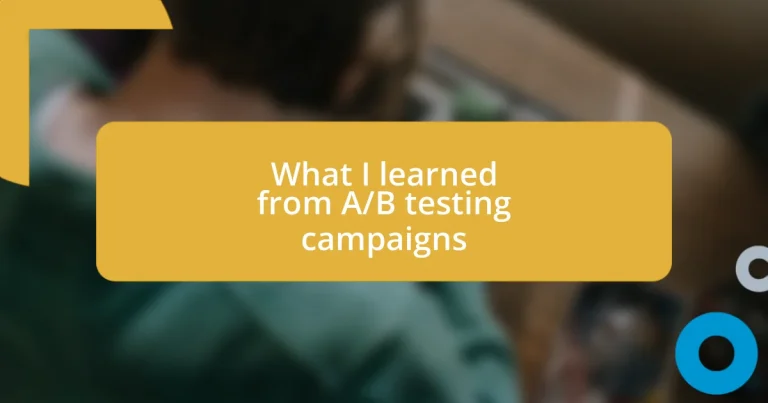Key takeaways:
- A/B testing is crucial for data-driven decision-making, helping to identify user preferences and improve outcomes through small changes.
- Key components of A/B testing include a clear hypothesis, adequate sample size, and appropriate test duration to ensure valid results.
- Implementing findings collaboratively and adapting strategies based on data insights can lead to more effective user engagement and improved campaign performance.
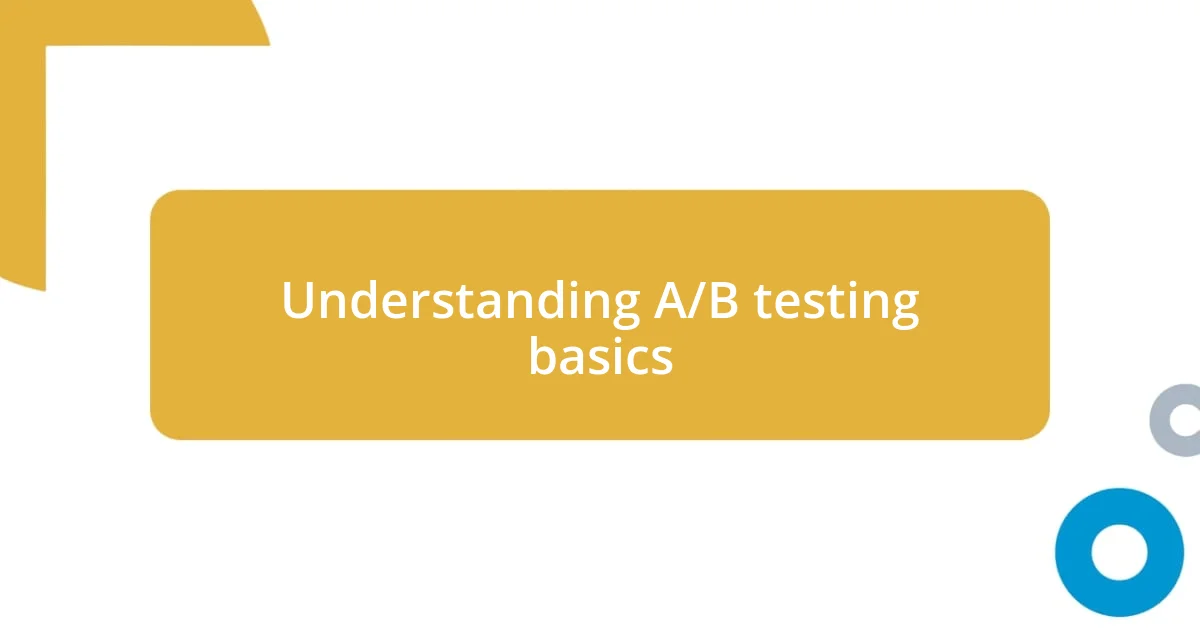
Understanding A/B testing basics
A/B testing is like a scientific experiment for marketers, where you create two versions of something—like a webpage or an email—and see which one performs better. I recall my excitement when I first launched an A/B test on a landing page; it felt like I was a detective uncovering clues on what my audience really wanted. Have you ever wondered how small changes can lead to significant differences? That’s the beauty of A/B testing.
At its core, A/B testing hinges on the simple idea of comparison. Picture this: you design one version with a bold red button and another with a calming blue one. It’s fascinating to watch as real users engage with your designs, revealing their preferences. I remember seeing a conversion increase of nearly 20% just by changing the color. It made me realize how crucial these seemingly minor details can be for the outcome.
Ultimately, the purpose of A/B testing is to eliminate guesswork and focus on data-driven decisions. Every test is a learning opportunity, opening my eyes to what truly resonates with my audience. When I reflect on my experiences, I see A/B testing as not just a tool, but a way to truly connect with users. It makes me think—how well do we really know our audience? By testing, we get to know them better, one hypothesis at a time.
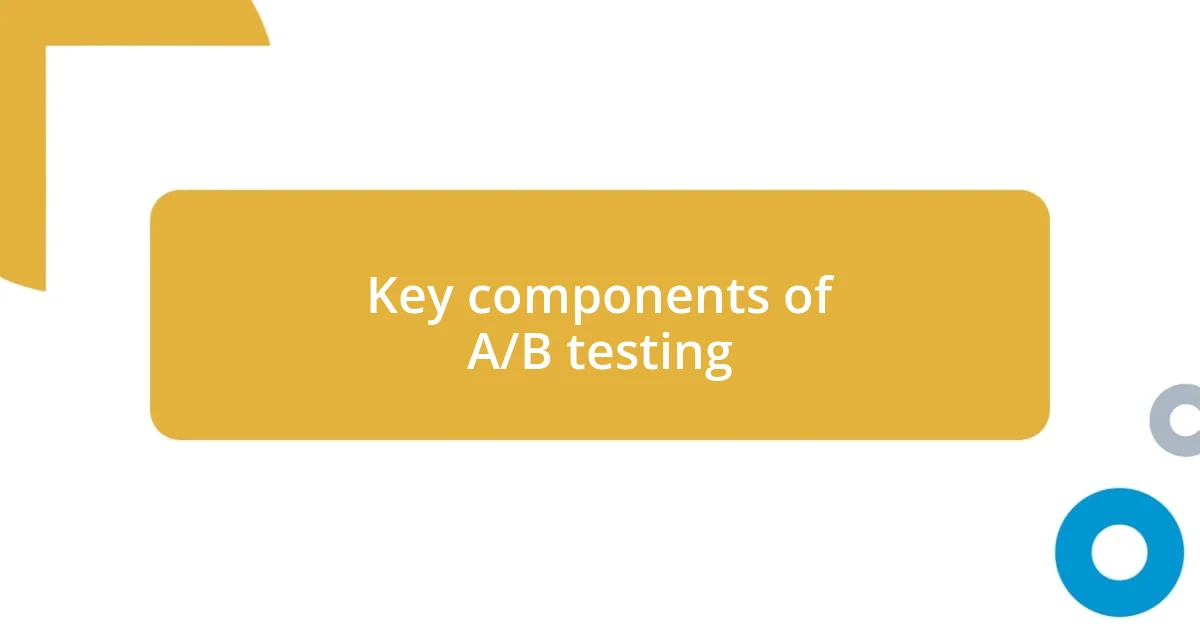
Key components of A/B testing
The first key component of A/B testing is the hypothesis. Crafting a clear and testable hypothesis sets the foundation for your campaign. I learned this the hard way during a campaign where I jumped into testing without a solid hypothesis, leading to confusion and inconclusive results. Reflecting on this, I’ve come to realize that a well-defined statement drives focus and clarity, making it easier to understand what you are really testing.
Another crucial component I’ve encountered is the sample size. In my experience, not considering the appropriate sample size can skew results. I recall one instance where I concluded that a new email subject line was a failure because my sample was too small. It was a frustrating lesson; the numbers needed to be larger for the findings to be statistically valid. It’s a stark reminder that significant insights often come from a larger pool of data.
Lastly, the duration of the test is a vital aspect. Running a test for too short a time can yield misleading outcomes, as I discovered with my initial tests, where I often made hasty decisions. Deliberating over a two-week period taught me that some findings need time to manifest. I’ve found that balancing time with engagement peaks can provide clearer insights and ultimately lead to better decision-making.
| Component | Description |
|---|---|
| Hypothesis | A statement driving the focus of your test. |
| Sample Size | The number of users included to validate results. |
| Test Duration | Length of time the test is active for reliable data. |
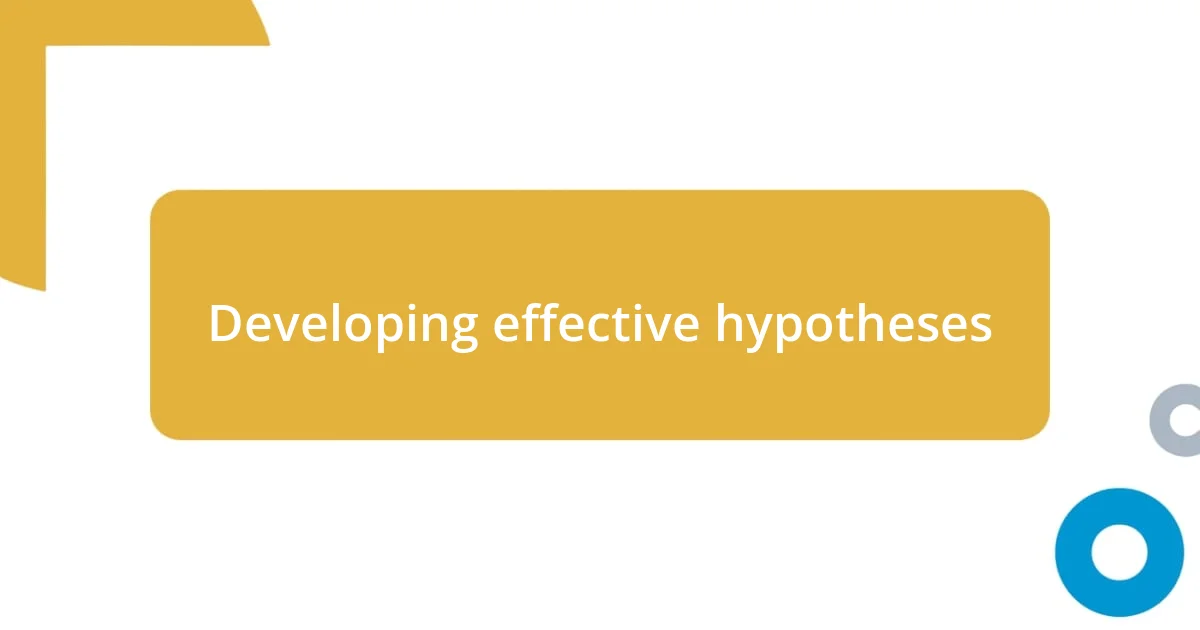
Developing effective hypotheses
I’ve found that developing effective hypotheses is often the cornerstone of a successful A/B testing campaign. A strong hypothesis informs your strategy and directs your efforts. I remember a time when I proposed a hypothesis that changing the headline on a landing page would increase sign-ups. The clarity of that statement guided the entire testing process, allowing my team to focus on what we needed to measure. This taught me the value of specificity in hypotheses, as they can transform uncertainty into direction.
When crafting a hypothesis, I suggest considering these essential aspects:
- Relevance: Ensure the hypothesis directly addresses a problem or question.
- Testability: It should be something you can clearly measure and evaluate.
- Clarity: Avoid vague language; be precise about what you expect to happen.
In my experience, incorporating these elements not only streamlines the testing process but also enhances the potential for actionable insights. I can’t stress enough how exhilarating it is to witness your hypothesis come to life through data, shaping your understanding of consumer behavior.
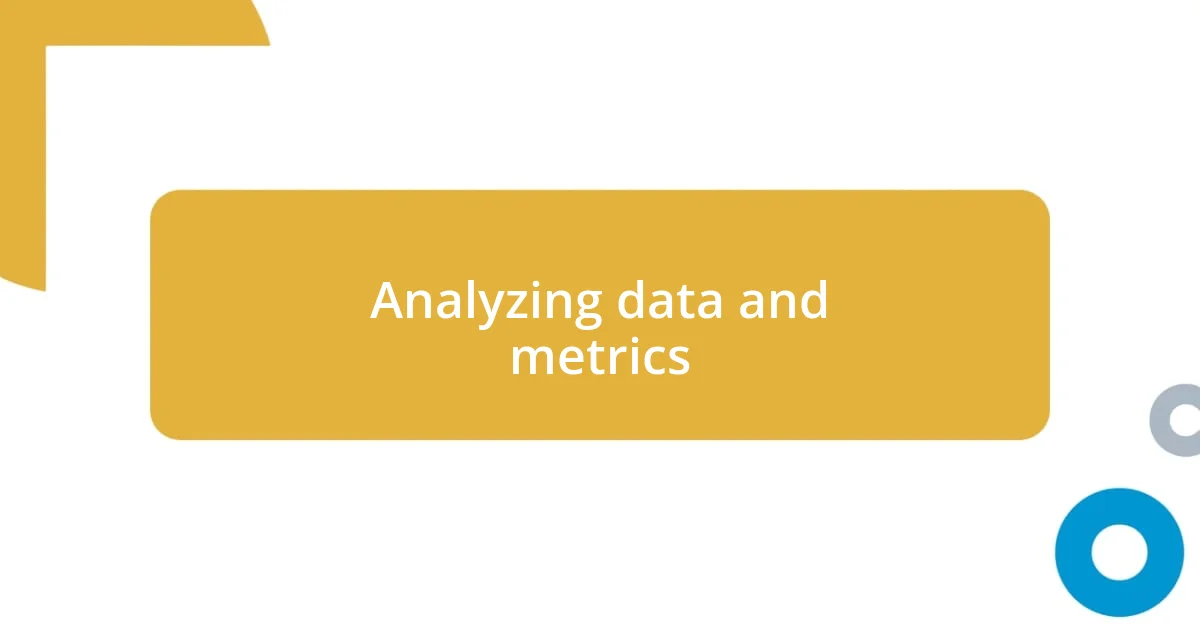
Analyzing data and metrics
When diving into the analysis of data and metrics from A/B testing, I’ve learned that it’s crucial to look beyond just the numbers. I vividly remember my excitement when I first saw a spike in conversions after a test. But then, I realized what truly mattered was understanding why that spike occurred. Was it the change in color, the wording, or perhaps the timing of the send? Digging deep into these questions has often unveiled insights that mere numbers can’t convey.
Another key lesson came when I started using metrics like conversion rate and engagement time more strategically. Initially, I was all about vanity metrics—those big, impressive numbers that look good on a report but lack depth. Over time, I shifted my focus to metrics that genuinely correlate with success. For example, when I concentrated on the user journey and drop-off rates, I spotted gaps in my content that needed attention. Have you ever sat down with a spreadsheet and wondered how many stories are hidden within those rows? That’s the magic of data analysis.
The importance of segmentation also struck me as I analyzed results. I distinctly remember a campaign where overall engagement looked promising, yet delving into user segments revealed stark differences in behavior. What if I hadn’t segmented the data? I would have overlooked valuable insights about my audience. This insight highlighted the necessity of tailor-making strategies for different user groups, and it transformed how I approach A/B testing. After all, we have to remember that our audience isn’t a monolith; they’re diverse and nuanced, and our data should reflect that.
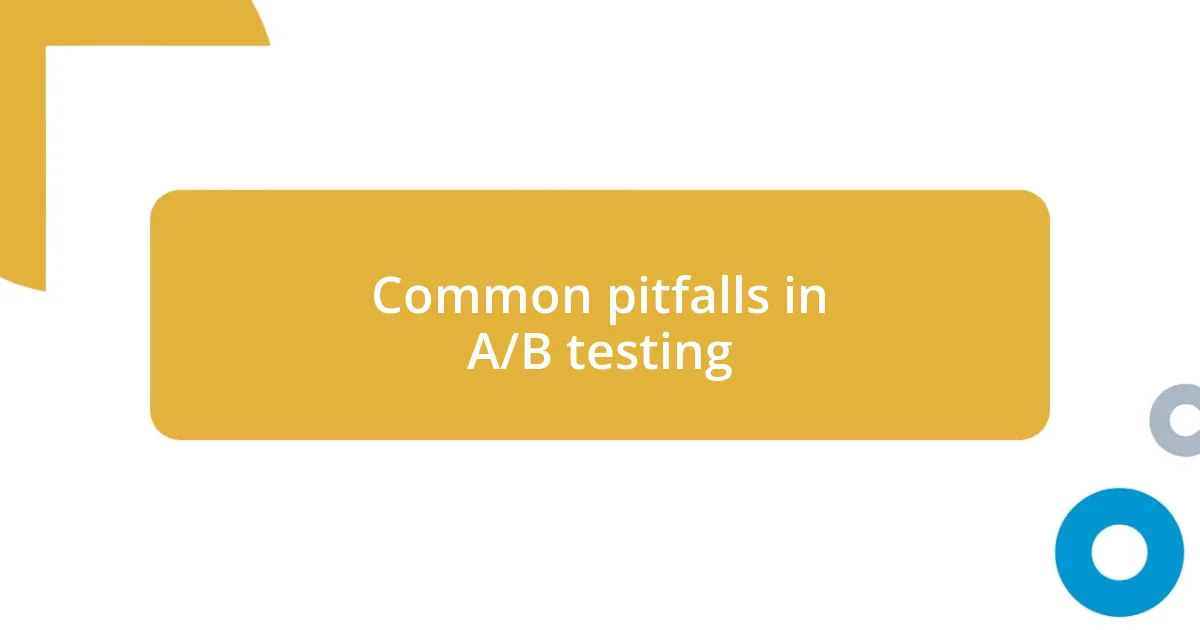
Common pitfalls in A/B testing
One common pitfall I’ve encountered in A/B testing is the tendency to run tests for too short a duration. Early in my career, I rushed to declare a winner after just a couple of days, eager to share success with my team. However, I quickly learned that short testing periods can lead to skewed results, especially if you’re missing out on collecting data from different user behaviors over time. Have you ever noticed how user engagement fluctuates between weekdays and weekends? That variability can dramatically affect your test outcomes, proving the need for patience.
Another misstep I’ve seen is neglecting sample size adequacy. I recall a project where we were excited about a potential 10% lift in conversions from a small audience. However, our sample size was too small to yield statistically significant results. The lesson was profound: larger samples help in drawing more reliable conclusions. In A/B testing, think of your sample size as setting the stage for a more accurate performance evaluation—missing this can lead to overconfidence in flawed data.
I also learned to be wary of testing too many variables simultaneously. I made this mistake during a campaign that altered multiple design elements. Initially, I believed I could capture more insights faster, yet it all backfired. The results became murky; I couldn’t pinpoint which change drove the impact. The experience taught me a valuable strategy: focus on one change at a time. By isolating variables, I could draw clearer conclusions, effectively unraveling the complexities of user behavior. Have you experienced the frustration of mixed results? Simplifying the testing process can help you avoid that confusing maze.
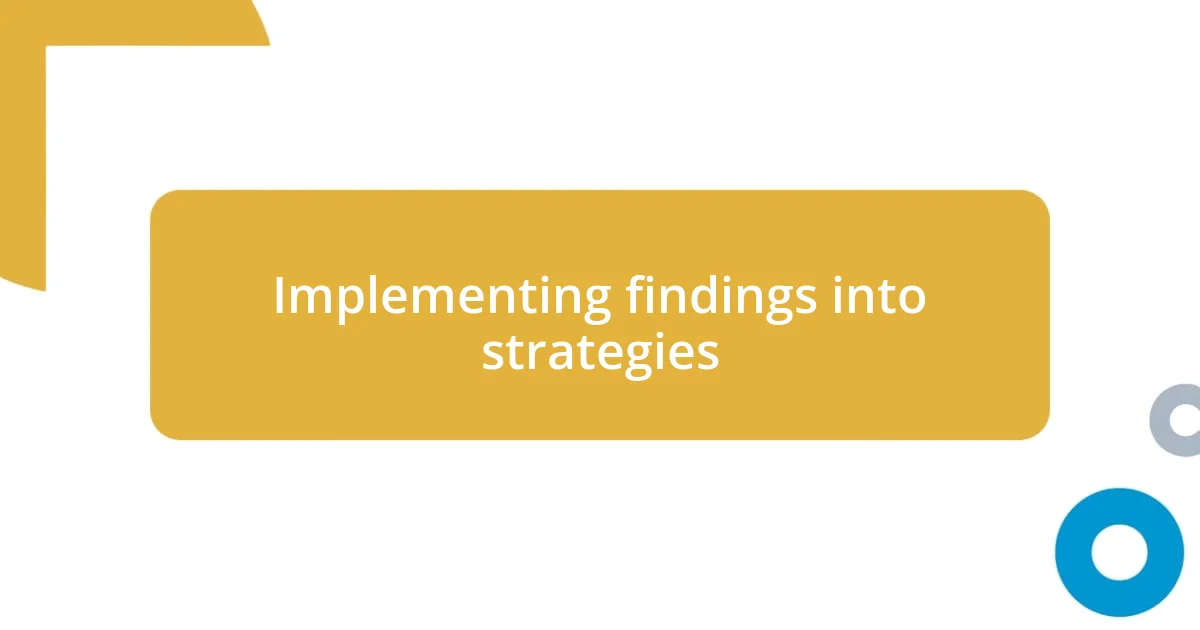
Implementing findings into strategies
When it comes to implementing findings from A/B testing into strategies, I’ve found the process can be quite exciting. A vivid memory strikes me from a campaign where a small tweak in the call-to-action drastically improved click-through rates. The thrill I felt upon realizing that a simple change could create such impact drove me to implement similar strategies across my future campaigns. Suddenly, I was no longer just an analyst; I became a strategist, thinking creatively about how each finding could shape my broader goals.
One of the most impactful strategies I adopted was involving my entire team in the implementation process. Early in my journey, I often kept insights to myself, driven by a competitive spirit. However, once I started sharing findings, I discovered the power of collaborative brainstorming. During one team meeting, a colleague suggested a unique way to present our tested features based on the data we had gathered. That moment was enlightening—it highlighted how different perspectives can enhance the application of data, often leading to even more innovative strategies.
I can’t stress enough how crucial it is to continually revisit and adapt strategies based on what the data reveals. I distinctly remember a campaign that initially whirred to life with impressive results but began to plateau. Instead of sticking to the same methods, I took a step back and analyzed shifting user behaviors. Doing so revealed that our messaging was no longer resonating as it once had. This reflection helped me course-correct and find new ways to engage my audience effectively. Have you ever felt the need to pivot, only to realize that sticking to known methods can be surprisingly limiting? It’s these moments of realization that can reshape how we approach our strategies moving forward.
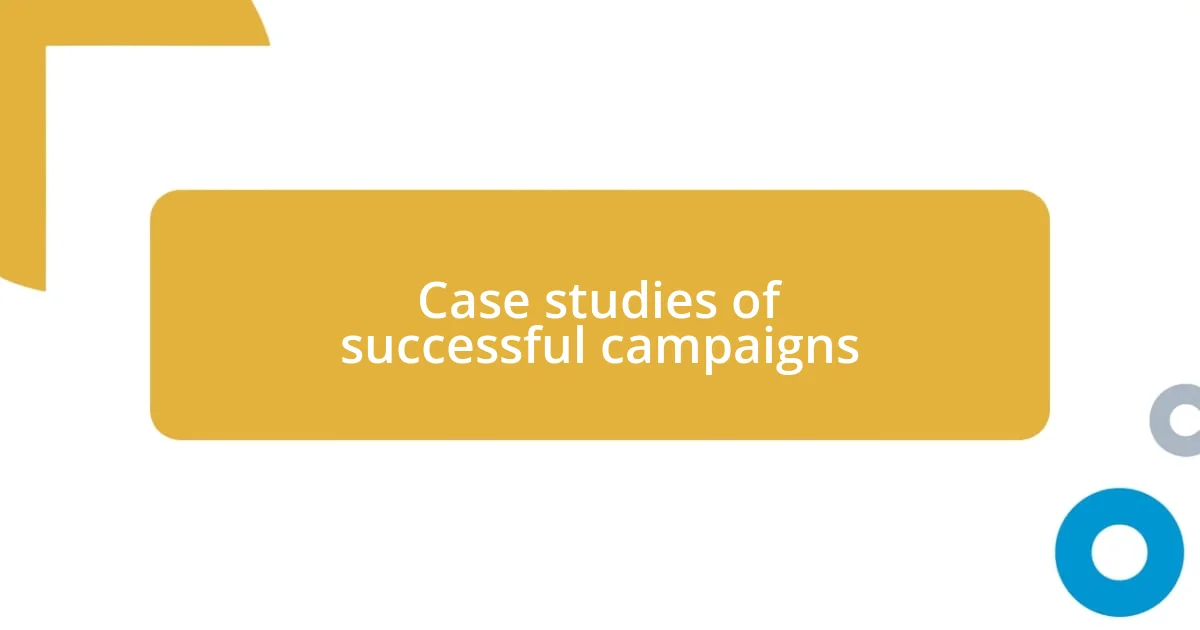
Case studies of successful campaigns
Let’s delve into a couple of inspiring case studies that highlight the power of A/B testing. One that stands out for me involved an e-commerce client struggling with cart abandonment rates. I was part of a team that tested a new checkout flow, simplifying the process by reducing the number of steps. The result? A staggering 30% decrease in abandonment, which was both thrilling and validating for everyone involved. It reminded me how seemingly minor tweaks can lead to significant improvements, driving home the value of informed testing.
Another memorable campaign I oversaw was with a SaaS product looking to boost user engagement. We ran a test on our onboarding email sequence, changing subject lines to be more personalized. Interestingly, the version with a user’s first name saw a whopping 40% higher open rate. Reflecting on that experience, I realized how personalization can create a deeper connection with recipients. It’s also one of those moments that makes you wonder: how many of our users are craving that personal touch, and how many opportunities do we miss by playing it too safe?
Lastly, I recall a social media campaign where we experimented with image types for our ads. One ad featuring user-generated content outperformed others by 60%. Seeing our audience respond so positively was genuinely rewarding. It made me ponder: why do we sometimes overlook the voices of our users? This campaign drove home the point that sometimes, the best ideas come directly from the people we aim to serve. Each of these case studies reinforced not only the importance of A/B testing but also the value of listening to our audience.












